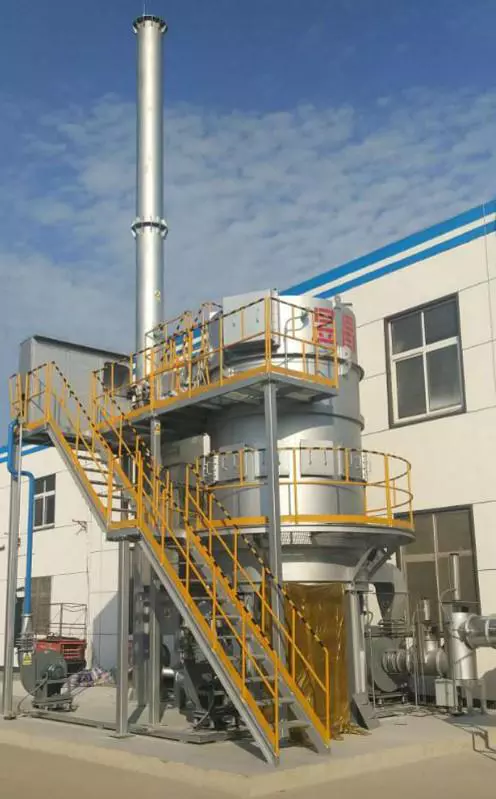RTO Thermal Oxidizer for Food Processing
介紹
In the food processing industry, the proper treatment of exhaust gases is crucial to ensure compliance with environmental regulations and maintain a safe working environment. One effective solution for controlling air pollution in food processing facilities is the Regenerative Thermal Oxidizer (RTO). This advanced technology not only reduces harmful emissions but also offers energy-efficient operation, making it an ideal choice for food processing plants.
How Does an RTO Work?
– The RTO operates based on the principle of thermal oxidation, where volatile organic compounds (VOCs) and hazardous air pollutants (HAPs) are converted into carbon dioxide and water vapor through high-temperature combustion.
– The system consists of multiple ceramic heat exchange beds, which alternate between the inlet and outlet streams to maximize heat recovery and minimize energy consumption.
– The VOC-laden air enters the RTO through an inlet manifold and passes through a preheating chamber, where it is heated to the desired temperature.
– The heated air then flows through one of the ceramic beds, where combustion takes place, releasing heat.
– The purified air is directed towards the outlet manifold, while the combustion byproducts are directed to a separate exhaust stack.
Advantages of RTOs in Food Processing
– Emission Control: RTOs efficiently destroy VOCs and HAPs, ensuring compliance with air quality regulations and reducing the environmental impact of food processing operations.
– Energy Efficiency: The regenerative design allows for high heat recovery rates, leading to significant energy savings. This is particularly beneficial for food processing facilities with large exhaust airflow rates.
– Reliability: RTOs are known for their reliability and durability, requiring minimal maintenance while providing consistent performance over an extended period.
– Flexibility: These systems can handle a wide range of process exhaust volumes and pollutant concentrations, making them suitable for various food processing applications.
– Cost-effectiveness: Despite the initial investment, the long-term cost savings achieved through reduced energy consumption and lower emissions make RTOs a financially viable solution for food processors.
Applications of RTOs in Food Processing
RTOs have found extensive use in various food processing applications due to their effectiveness in treating the exhaust gases generated. Some notable applications include:
– Baking and Roasting: RTOs can effectively handle the emissions from ovens and roasters used in the baking and roasting processes, eliminating odors and reducing harmful pollutants.
– Frying and Grilling: The exhaust gases generated during frying and grilling operations contain significant amounts of VOCs. RTOs efficiently destroy these compounds, improving air quality.
– Drying and Curing: RTOs are commonly used to treat the exhaust gases from drying and curing processes in the food industry. They ensure that the released gases meet environmental standards.
– Rendering and Rendering: The rendering process produces strong odors and releases potentially harmful compounds. RTOs provide an effective solution for odor control and emission reduction.
結論
Overall, the implementation of RTO thermal oxidizers in food processing facilities offers numerous benefits, including emission control, energy efficiency, reliability, flexibility, and cost-effectiveness. By utilizing this advanced technology, food processors can ensure regulatory compliance, protect the environment, and maintain a safe working environment. The extensive applications of RTOs in various food processing operations make them an essential component of sustainable and responsible industrial practices.

公司簡介
We are a high-tech equipment manufacturing enterprise that focuses on comprehensive treatment of volatile organic compounds (VOCs) exhaust and carbon reduction and energy-saving technologies in the field of food processing. Our core technologies include thermal energy, combustion, sealing, and self-control, with the ability to simulate temperature fields and air flow fields, and to conduct experimental tests on ceramic heat storage material properties, molecular sieve adsorption materials selection, and high-temperature combustion and oxidation characteristics of VOCs organic compounds. We have an RTO technology R&D center and waste gas carbon reduction engineering technology center in Xi’an, and a 30,000 square meters production base in Yangling. Our core technology team comes from the Aerospace Liquid Rocket Engine Research Institute (Aerospace Sixth Academy). We have over 360 employees, including more than 60 R&D technical backbone members, 3 senior engineers at the research professor level, 6 senior engineers, and 195 thermodynamics PhDs.
Our core products are the rotary valve-type regenerative thermal oxidizer (RTO) and the molecular sieve adsorption concentration rotor, in combination with our own environmental protection and thermal energy system engineering technology expertise, we can provide customers with comprehensive industrial waste gas treatment and energy utilization carbon reduction integrated solutions for various working conditions.
Certification, Patent and Honor
We have obtained knowledge management system certification, quality management system certification, environmental management system certification, construction industry enterprise qualification, high-tech enterprise, rotary heat storage and oxidation furnace rotary valve patent, rotary heat storage incinerator rotor device patent, and disc-shaped molecular sieve rotor patent, etc.

How to Choose the Right RTO Equipment
When choosing the right RTO equipment, several factors must be considered:
- Determine exhaust characteristics
- 了解當地法規和排放標準
- 評估能源效率
- 考慮維
- 預算和成本分析
- Choose the appropriate RTO type
- 考慮環境和安全因素
- 效能測試與驗證
It is important to carefully evaluate each factor and make informed decisions based on the specific needs of the company.

服務流程
Our service process includes:
- Consultation and evaluation: preliminary consultation, on-site inspection, needs analysis
- Design and plan formulation: scheme design, simulation and emulation, scheme review
- Production and manufacturing: customized production, quality control, factory testing
- Installation and commissioning: on-site installation, commissioning operation, training services
- After-sales support: regular maintenance, technical support, spare parts supply
Our professional team will provide customers with a one-stop RTO solution tailored to their needs.
作者:米婭
